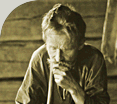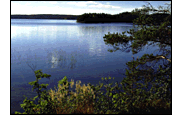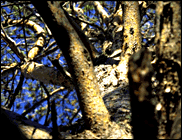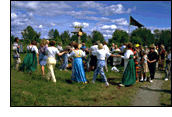 |
| Main page | Background | Villages | Revitalisation | Cultural tourism | Map | |
Beautiful Village - Ugly Fate |
Akonlahti Ugly fate of Akonlahti What to see |
 The
houses in the villages of Akonlahti are bigger and grander than those
in Viena generally. The village was a wealthy one. Conditions were
favorable for farming, fishing and hunting, and the proximity of the
border made trade fruitful as well. Before the border was closed,
the villagers of Akonlahti dealt with the people in the Finnish village
of Rimpi on an everyday basis. Even after the border was officially
closed in the 1920s, contact between the villages continued for some
time. The
houses in the villages of Akonlahti are bigger and grander than those
in Viena generally. The village was a wealthy one. Conditions were
favorable for farming, fishing and hunting, and the proximity of the
border made trade fruitful as well. Before the border was closed,
the villagers of Akonlahti dealt with the people in the Finnish village
of Rimpi on an everyday basis. Even after the border was officially
closed in the 1920s, contact between the villages continued for some
time.
During the Continuation War (1941-44), the villages of Akonlahti were occupied by the Finns, and not all of the people succeeded in leaving the village before it was occupied. Life continued - as normally as possible under the circumstances - but when the war ended, many of the villagers moved to Finland, fearing that they would be accused of collaboration with the Finnish enemy if they stayed in Russia. After the War, life in the villages continued around the collective farm that had been established in the area. The post-War population comprised former permanent residents of the village, returning evacuees, and people from villages whose houses had been destroyed in the conflict. Efforts were made to concentrate habitation in the village of Akonlahti proper.
The destruction of the village was extraordinarily violent, although various explanations have since been advanced to tone down the harshness of the event. In 1958, the authorities responsible for liquidating the village sent in airplanes, which landed on the ice of Lake Kiitehenjärvi. The villagers were given a few hours to gather their belongings. And then it was time to leave. Children, the elderly and calves were taken by plane to Uhtua; everyone else had to walk there with the livestock. Yet virtually every family had to slaughter their animals, because there was no hay or other fodder for them where they were going. To seal the village's fate, all of the houses were then burnt to the ground, so that no one would have the remotest chance of returning. Fortunately, Väinö Kaukonen and Vilho Uomala had photographed Akonlahti and its surroundings during the War. Future generations will at least have these images to help them appreciate the village that played the most significant role in the Karelian building tradition.
|

 When
Finland and the Soviet Union established a "Park of Friendship"
in 1991, the Akonlahti area became part of a nature preservation
area. When the Park was first founded, only researchers were allowed
to go to the shores of Lake Kiitehenjärvi. Later, however, Park
administrators and the Folklore Villages Project, set up to preserve
and revitalize the culture of the song-lands of the Kalevala, reached
an understanding whereby buildings can once again be built in the
Karelian style in Akonlahti and the village will be opened up to
travellers interested in culture and nature.
When
Finland and the Soviet Union established a "Park of Friendship"
in 1991, the Akonlahti area became part of a nature preservation
area. When the Park was first founded, only researchers were allowed
to go to the shores of Lake Kiitehenjärvi. Later, however, Park
administrators and the Folklore Villages Project, set up to preserve
and revitalize the culture of the song-lands of the Kalevala, reached
an understanding whereby buildings can once again be built in the
Karelian style in Akonlahti and the village will be opened up to
travellers interested in culture and nature.